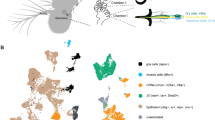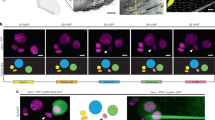Abstract
The function of the nervous system depends on the formation of a net of appropriate connections. This process must be at least partly under genetic control, yet the genetic analysis of the development of specific nerve connections has so far made little progress (reviewed in ref. 1). This is in part because of the immense complexity of the connective net. The problem is simpler in the case of insect secondary neurones which are derived from the epidermis and send their axons centripetally towards the central nervous system2. The arrangement of sense organs on the body surface is very reproducible in many cases, so that given neurones can be recognized unambiguously in different individuals. In Drosophila, the genetic analysis of development has so far concentrated on the epidermis. The genetic control of segmentation is relatively well understood3,4 and it has been found that segments are progressively subdivided in smaller developmental units called compartments5. This led to the speculation that sensory neurones belonging to different compartments might have different properties6. Here we show that the stimulation of mechanoreceptor bristles at different positions on the notum and legs of Drosophila specifically evoke different behavioural responses. This specificity depends on the segmental and in some cases on the compartmental identity of the bristle, but not on the site of entry of the axon into the central nervous system.
This is a preview of subscription content, access via your institution
Access options
Subscribe to this journal
Receive 51 print issues and online access
$199.00 per year
only $3.90 per issue
Buy this article
- Purchase on Springer Link
- Instant access to full article PDF
Prices may be subject to local taxes which are calculated during checkout
Similar content being viewed by others
References
Quinn, C. & Gould, J. L. Nature 278, 19–23 (1979).
Wigglesworth, V. B. Q. J. microsc. Sci. 94, 93–112 (1953).
Lewis, E. B. Nature 276, 565–570 (1978).
Garcia-Bellido, A. & Capdevila, M. P. in The Clonal Basis of Development (eds Sobtenly, S. & Susex, I.)3–21 (Academic, New York, 1979).
Garcia-Bellido, A., Ripoll, P. & Morata, G. Nature new Biol. 245, 251–253 (1973).
Crick, F. H. C. & Lawrence, P. A. Science 189, 340–347 (1975).
Sharma, R. P. & Chopra, V. L. Devl Biol. 48, 461–465 (1976).
Deak, I. I. Devl Biol. 66, 422–441 (1978).
Lewis, E. B. Am. Zoologist 3, 33–56 (1963).
Ghysen, A. Nature 274, 869–872 (1978).
Steiner, E. Wilhem Roux' Archiv. 180, 9–30 (1976).
Morata, G. & Lawrence, P. A. in The Clonal Basis of Development (eds Sobtenly, S. & Susex, I.) 45–60 (Academic, New York, 1978).
Anderson, H. & Bacon, J. Devl Biol. 72, 364–373 (1979).
Ghysen, A. Devl Biol. (in the press).
Bate, M. J. exp. Biol. 59, 95–107 (1973).
Author information
Authors and Affiliations
Rights and permissions
About this article
Cite this article
Vandervorst, P., Ghysen, A. Genetic control of sensory connections in Drosophila. Nature 286, 65–67 (1980). https://doi.org/10.1038/286065a0
Received:
Accepted:
Issue Date:
DOI: https://doi.org/10.1038/286065a0
This article is cited by
-
Altered Grooming Cycles in Transgenic Drosophila
Behavior Genetics (2024)
-
Co-option of epidermal cells enables touch sensing
Nature Cell Biology (2023)
-
The Drosophila homologue of Rootletin is required for mechanosensory function and ciliary rootlet formation in chordotonal sensory neurons
Cilia (2015)
-
Structural and functional analysis of single neurons to correlate synaptic connectivity with grooming behavior
Nature Protocols (2014)
-
Serotonergic neurons of the Drosophila air-puff-stimulated flight circuit
Journal of Biosciences (2014)
Comments
By submitting a comment you agree to abide by our Terms and Community Guidelines. If you find something abusive or that does not comply with our terms or guidelines please flag it as inappropriate.



